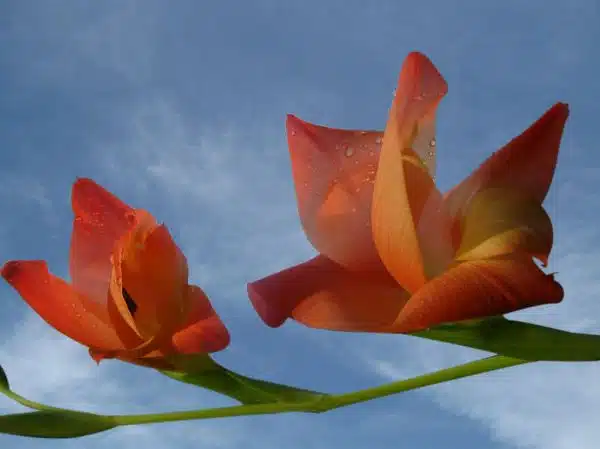As a floral care expert, keeping flowers fresh is of paramount importance to me. Flowers are not only beautiful but also have the power to lift the mood and brighten up any space. However, without proper care, flowers can wilt and lose their beauty quickly. In this article, I will share some tips on how to keep flowers fresh for as long as possible.
The first step in ensuring that your flowers stay fresh is by choosing the right type of flower. Some flowers are hardier than others and can last longer even without proper care. When selecting flowers, consider those with woody stems such as roses or sunflowers, which tend to last longer than delicate blooms like lilies or tulips. Additionally, it’s essential to buy flowers that haven’t fully bloomed yet since they will continue to open up and look fresher for longer. With these tips in mind, let’s delve into some practical ways of keeping your flowers looking vibrant and fresh for days on end.
Choosing The Right Flowers
When it comes to creating beautiful flower arrangements, choosing the right flowers is crucial. As a floral care expert, I cannot stress enough the importance of selecting fresh and healthy blooms. Not only will this guarantee a longer vase life, but it will also ensure that your color scheme looks vibrant and cohesive.
One key factor in choosing the right flowers is to consider the occasion. Are you creating a romantic bouquet for a loved one? Or perhaps a cheerful centerpiece for a dinner party? Different occasions call for different types of flowers, so be sure to choose accordingly. For example, if you’re going for a romantic look, opt for roses or peonies in shades of pink or red. For a more casual vibe, sunflowers or daisies in bright yellows and oranges are perfect.
Another important aspect to consider when selecting flowers is their color scheme. When arranging flowers, it’s crucial to choose hues that complement each other and create an overall harmonious look. Some classic combinations include white and green for an elegant feel, or purple and yellow for a bold pop of color. Whatever color scheme you choose, make sure it matches the occasion and evokes the desired emotional response from your audience.
When preparing your vase for your chosen flowers, keep in mind that certain vessels work better with certain types of blooms. A tall vase with a narrow opening is great for long-stemmed flowers like lilies or gladioli, while a shorter vase with a wider mouth is ideal for fuller blooms like roses or hydrangeas. By taking these factors into consideration when selecting your flowers and preparing your vase, you’ll be well on your way to creating stunning floral arrangements that will impress any guest.
Preparing The Vase
After carefully selecting the perfect flowers for your arrangement, it’s time to prepare the vase. Decorative vases are an excellent choice for showcasing your blooms, but don’t overlook other alternatives such as mason jars or repurposed containers. Whatever vessel you choose, make sure it’s clean and free of any dirt or residue.
For decorative vases, consider the shape and size of the opening when selecting flowers. A wider opening is ideal for larger arrangements with more stems, while a narrower neck is better suited for a single stem or smaller bouquet. It’s also important to consider the height of the vase in relation to the flowers; a tall vase may require more stems to fill adequately.
If using a non-traditional vase alternative, be creative with your arrangement by incorporating unique elements such as twine or ribbon for added texture and interest. Remember to always add water to your vase before arranging your flowers and ensure that no leaves rest below the waterline as they can cause bacteria growth. With proper preparation, your flowers will last longer and look stunning in their chosen vessel.
Transition into subsequent section: Now that you have selected the perfect vase for your blooms, it’s essential to keep it clean to prevent bacterial growth and ensure longevity for your arrangement.
Cleaning The Vase
The cleanliness of the vase is crucial for maintaining the freshness of flowers. Any residue in the vase can contaminate the water and affect the health of flowers. Therefore, cleaning techniques are necessary to keep flowers fresh for longer periods. The first step is to empty any leftover water and rinse out the vase with warm soapy water. It would be best if you used a soft-bristled brush to clean out any residue inside the vase.
Preventing algae growth is also essential in maintaining flower freshness. Algae develop when sunlight reaches the water in the vase, leading to bacterial growth that can harm flowers’ health. To prevent this, keep your vase away from direct sunlight and change its location frequently. Additionally, adding a small amount of bleach or white vinegar to the water can help maintain its cleanliness and prevent bacterial growth.
Maintaining a clean and healthy environment for your flowers is crucial in preserving their freshness. Through proper cleaning techniques and preventing algae growth, you can extend their lifespan significantly. However, even with these precautions, it’s vital to cut stems frequently to ensure that they continue to receive adequate nutrients and hydration.
Cutting The Stems
Proper stem cutting is the key to keeping your flowers fresh for a longer period. Here are some tips to make sure that you get it right. Firstly, make sure that you use sharp and clean scissors or a knife when cutting the stems. Dull blades can damage the tissue and prevent proper water uptake, leading to the flowers wilting prematurely.
The length of stems that should be cut depends on the type of flower you have. For instance, roses need long stems as they have a large vascular system that requires a lot of water. On the other hand, daffodils only need short stems as they have smaller vascular systems. When cutting, it’s essential to ensure that you cut at an angle to increase the surface area for water uptake.
Additionally, remove any leaves that will fall below the waterline before placing them in a vase. This will prevent bacterial growth and keep your flowers fresh for longer. However, don’t remove all leaves from the stem; a few leaves near the bloom will help photosynthesis and prolong their life span. Follow these tips for successful stem cutting, and we’ll move on to trimming the leaves in our next segment.
Trimming The Leaves
Trimming the Leaves:
Trimming the leaves of flowers is an important aspect of floral care that is often overlooked. By removing excess foliage, you can help extend the life of your flowers and improve their overall appearance. One of the main benefits of trimming leaves is that it helps to reduce water loss from the stem. When leaves are left on a flower stem, they continue to transpire water even after the flower has been cut, leading to premature wilting. By removing some of these leaves, you can slow down this process and keep your flowers fresh for longer.
However, it’s important to avoid common mistakes when trimming leaves. One mistake people often make is removing too many leaves at once. While it’s true that too many leaves can lead to excessive water loss, removing too many at once can shock the plant and cause it to wilt prematurely. Instead, aim to remove only a few leaves at a time, starting from the bottom of the stem and working your way up.
Another common mistake is cutting into the stem itself when trimming leaves. This can damage the vascular system of the plant and prevent it from taking up water properly. Instead, use sharp scissors or pruning shears to make clean cuts just below where each leaf attaches to the stem.
In preparation for adding flower food in our subsequent section topic, it’s important to have properly trimmed stems for optimal water uptake by flowers. With trimmed foliage out of the way, we’re now ready for our next step in keeping our flowers looking beautiful and fresh for as long as possible: adding flower food!
Adding Flower Food
As a floral care expert, I highly recommend using flower food to keep your flowers fresh. This simple addition can make a significant difference in the lifespan of your blooms. Flower food contains various nutrients that help to nourish your flowers and keep them looking vibrant for longer periods.
If you don’t have access to flower food, you can also consider using alternative preservatives such as aspirin or sugar. Aspirin works by lowering the pH level of the water, which helps to prevent bacteria growth and increase water uptake by the flowers. Sugar, on the other hand, provides energy to the flowers and helps them stay hydrated.
In some cases, you may need to preserve your flowers without water. To do this, simply hang your bouquet upside down in a dry area with good ventilation. This method is ideal for preserving dried flowers or for creating long-lasting arrangements that don’t require water. By following these simple tips, you can ensure that your flowers remain fresh and beautiful for as long as possible.
To further extend the life of your flowers, it’s important to change the water regularly. This helps to prevent bacterial growth and ensures that your blooms are receiving a fresh supply of nutrients. Additionally, be sure to trim the stems at an angle every few days to promote better water absorption. With proper care and attention, even delicate blooms can last for weeks instead of just a few days.
Changing The Water
After adding flower food to the vase, it is important to change the water frequently to keep flowers fresh. The timing of water changes is crucial in ensuring that the flowers receive optimal care. Ideally, the water should be changed every two days or whenever it appears cloudy or murky.
Frequent water changes help prevent bacteria growth and provide fresh nutrients to the flowers. When changing the water, it is recommended to trim about an inch off the stems at a 45-degree angle and remove any leaves that will be submerged in the new water. This ensures that the stems can absorb more water and nutrients easily.
In addition to changing the water regularly, keeping flowers cool can also help prolong their lifespan. Heat accelerates the aging process of flowers, causing them to wilt and lose their vibrancy quickly. Therefore, it is essential to keep flowers away from direct sunlight and sources of heat such as radiators or electronics. By following these steps, you can ensure that your cut flowers stay fresh for longer periods, adding beauty and joy to your space.
Keeping Flowers Cool
- Refrigerators provide an ideal environment for storing flowers; temperatures should be kept between 34-38 degrees Fahrenheit and the environment should be kept dry.
- Cool locations, such as basements or cellars, provide a suitable environment for storing flowers; temperatures should not exceed 75 degrees Fahrenheit and the environment should be kept cool and dry.
- Hydrating blooms is essential to keeping flowers cool; blooms should be hydrated every 3-4 hours with a floral preservative solution to keep them fresh and vibrant.
- Blooms should not be stored in direct sunlight or in front of heaters, as this will cause them to dry out and wilt faster.
- In order to keep blooms fresh, cut stems should be re-cut and placed in a cool water bath with a floral preservative solution.
- Flower stems should always be kept in cool water and should not be exposed to temperatures higher than 70 degrees Fahrenheit.
Storing Flowers In Refrigerators
Imagine walking into a room and being enveloped by the sweet fragrance of fresh flowers. This sensory experience can brighten up even the dullest day, but how can we ensure that these natural treasures remain fresh for as long as possible? One effective way to keep flowers cool is by storing them in a refrigerator.
As a floral care expert, I highly recommend using this method to extend the life of your blooms. Not only does it help prevent wilting and fading, but it also preserves their fragrances. However, it’s important to choose the right temperature for storing flowers. Most refrigerators are set at around 40°F (4°C), which is ideal for most types of flowers. However, some delicate varieties such as orchids may require slightly higher temperatures.
One of the benefits of floral fragrances is their ability to stimulate our senses and elevate our mood. By keeping flowers fresh through proper storage techniques such as refrigeration, we can enjoy their beauty and aroma for longer periods of time. So next time you receive a bouquet or buy fresh blooms from your local florist, consider storing them in your refrigerator to maximize their longevity and fragrance!
Choosing Cool Locations
To ensure that flowers remain fresh and vibrant for as long as possible, it’s crucial to choose the right location for storing them. While refrigeration is a popular method, there are other cool locations that can also help maintain the quality of your blooms. As a floral care expert, I highly recommend exploring different options to find what works best for your specific type of flower.
One benefit of refrigerating flowers is its ability to slow down the aging process and prevent wilting. However, it’s important to note that not all flowers can withstand the cold temperature of a refrigerator. For instance, tropical flowers such as hibiscus and plumeria may suffer from damage if stored in temperatures below 50°F (10°C). Therefore, it’s essential to research the ideal temperature range for your specific type of flower before deciding on a storage location.
Aside from refrigeration, other cool locations include basements, garages or even outdoors in shaded areas. The main advantage of these options is their natural cooling effect without exposing the flowers to extreme cold temperatures. Nonetheless, it’s crucial to monitor humidity levels and avoid direct sunlight exposure as these factors can impact the lifespan and quality of your blooms. Overall, choosing the right location for storing your flowers can make a significant difference in extending their longevity and preserving their beauty.
Hydrating Blooms
In addition to choosing the right location for storing flowers, hydration is another crucial factor in keeping them cool and fresh. Proper hydration ensures that blooms receive the necessary nutrients to maintain their vibrancy and prevent wilting. Using plant food or flower nutrients can also help extend the lifespan of your flowers.
Before placing flowers in a vase or container, it’s essential to prepare them properly for hydration. This includes trimming the stems at an angle, removing any leaves that may be submerged in water, and filling the vase with clean water mixed with plant food or flower nutrients. It’s also crucial to change the water every two days and re-cut the stems at an angle to allow for better absorption of water and nutrients.
Another important tip for hydrating blooms is to avoid overcrowding them in a vase or container. Overcrowding can lead to competition for resources such as water and nutrients, which can impact the longevity and quality of your flowers. Instead, opt for a spacious vase that allows each bloom to have enough room to absorb water and nutrients effectively. By following these tips, you can ensure that your flowers stay hydrated and cool for as long as possible.
Avoiding Direct Sunlight
It cannot be emphasized enough how important it is to keep flowers properly hydrated in order to maintain their freshness. However, hydration alone is not enough if the flowers are left in direct sunlight. The combination of proper hydration and avoiding direct sunlight is crucial for keeping flowers fresh.
Direct sunlight can cause flowers to wilt and lose their vibrant colors at a faster rate than usual. When exposed to the sun’s intense heat, the water evaporates from the petals and leaves, causing them to dry out quickly. This results in wilting and drooping, which ultimately shortens the vase life of the flower.
To avoid this issue, it is best to place your bouquet or arrangement in a cool location away from direct sunlight. If you must display your flowers in an area with natural light, make sure that they are not exposed to direct sunlight for extended periods of time. By following these simple steps, you can extend the life of your flowers and enjoy their beauty for longer.
Proper hydration and avoiding direct sunlight are two key factors in maintaining the freshness of your blooms. However, there are additional steps you can take to ensure your flowers stay beautiful for as long as possible. In the next section, we will explore how using floral preservatives can help prolong the life of cut flowers even further.
Using Floral Preservatives
Floral preservatives are an effective way to keep flowers fresh for a longer period. These preservatives contain ingredients that help to nourish the flowers and prevent bacterial growth in the vase water. Using floral preservatives properly can greatly enhance the lifespan and beauty of your flower arrangements.
One important factor when using floral preservatives is mixing them correctly. It’s essential to follow the instructions on the package carefully, as over-diluting or under-diluting can affect their effectiveness. As a general rule, use one packet of preservative per quart of water, and mix it thoroughly before adding the flowers. This will ensure that each stem receives enough nutrients and bacteria-fighting agents.
When comparing different types of floral preservatives, it’s crucial to assess their effectiveness based on factors such as how long they keep the flowers fresh and how well they prevent bacterial growth. Some preservatives may be more effective than others depending on the type of flower or environment in which they are placed. Consulting with a florist or doing research online can help you choose the best product for your specific needs.
To make sure your flowers stay fresh even longer, there are some additional tips you can follow when using floral preservatives. Keep the vase clean by changing the water every few days, and always trim the stems at an angle before placing them in fresh water with new doses of floral preservative added in. With these simple steps, you’ll be able to enjoy beautiful blooms for much longer!
Transition: In addition to using floral preservatives, another key step in keeping your flowers looking their best is misting them regularly.
Mist Your Flowers
Imagine you are walking in a garden on a sunny day. The flowers are blooming and the air is filled with their sweet fragrances. As you approach a patch of flowers, you notice tiny droplets of water glistening on the petals. This is what misting can do for your flowers. It not only adds moisture to your bouquet but also helps it stay fresh longer.
The benefits of misting your flowers are numerous. When you mist your flowers, you help them absorb moisture through their leaves and petals. This added moisture can help prevent wilting and keep the flowers looking fresh for days longer than if they were not misted. Additionally, misting can help remove any dust or debris that may have settled on the flower’s surface, which can improve its overall appearance.
The best time to mist your flowers is in the morning or early evening when temperatures are cooler and humidity levels are higher. If possible, use distilled or filtered water to avoid any minerals or chemicals that may harm your plants over time. Hold the spray bottle about 6-8 inches away from the bouquet and lightly mist until all surfaces have been covered. Be careful not to over-mist as this can lead to mold growth or damage delicate petals.
As important as it is to keep fresh flowers hydrated, sometimes they still dry out despite our best efforts. In such cases, rehydrating dried-out flowers can be done using simple techniques like recutting stems at an angle and placing them in warm water for a few hours or overnight before returning them to their vase with fresh water and preservative solution. By following these care tips, you can enjoy beautiful blooms for longer periods of time while serving others by sharing nature’s beauty with those around you.
Rehydrating Dried-Out Flowers
To rehydrate dried-out flowers, there are two commonly used methods: Soak method and Mist method. Both of these methods work well and can be used for various types of flowers. However, it is important to note that not all flowers will respond to rehydration in the same way, so it is essential to research your specific flower type before proceeding.
The Soak method involves submerging the entire stem of the dried-out flower in warm water for a period ranging from 30 minutes to 4 hours. This method works well for flowers with sturdy stems like roses, sunflowers, and chrysanthemums. After soaking, gently pat dry the flowers with a towel and transfer them to a vase filled with fresh water. Ensure you change the water every day to prevent bacteria growth and prolong their lifespan.
Alternatively, you can use the Mist method by filling a spray bottle with lukewarm water and gently misting the dried-out flowers until they are moist but not dripping wet. This method works best for delicate blooms like orchids or carnations that cannot handle being submerged in water. Once misted, wrap each stem individually in damp paper towels and place them inside a plastic bag. Leave them overnight in a cool space before transferring them to a vase filled with fresh water.
Now that your dried-out flowers have been rehydrated using either the Soak or Mist method, it’s time to move on to reviving wilting flowers. By following these simple steps, you can ensure your floral arrangements remain vibrant and beautiful for much longer than usual!
Reviving Wilting Flowers
After rehydrating dried-out flowers, the next step is to revive wilting flowers. Did you know that 60% of cut flowers die within a week of being cut? This is because they are no longer receiving water and nutrients from their roots. Therefore, it is important to keep them hydrated and fed to extend their lifespan.
One way to do this is by using plant food. Plant food contains essential nutrients that help flowers stay healthy and vibrant for longer periods of time. Simply mix the plant food with water according to the package instructions, and use this solution to water your flowers instead of plain tap water. This will not only keep them hydrated but also provide them with the necessary nutrients they need.
Another way to extend the life of your flowers is by creating DIY flower arrangements. By arranging your own bouquet, you have more control over which flowers are used and how they are arranged. You can also choose complementary colors and textures to create a visually stunning display. When arranging your bouquet, make sure to trim the stems at an angle before placing them in water, as this will allow them to absorb more water and nutrients.
With these tips in mind, you can now confidently care for your fresh-cut flowers at home. In the next section, we will discuss how storing flowers overnight can help preserve their freshness even further.
Storing Flowers Overnight
When it comes to storing flowers overnight, there are a few key things to keep in mind. First and foremost, it’s important to choose the right container. A vase with a narrow neck is ideal, as this will help support the stems of your flowers and prevent them from bending or breaking. You’ll also want to ensure that your container is clean and free from any bacteria or debris that could harm your blooms.
Once you’ve chosen your container, fill it about halfway with cool water. You can also add a packet of flower food if you have one on hand. This will help nourish your flowers and keep them looking fresh for longer. Next, trim the stems of your flowers at an angle under running water. This will help them absorb more water and stay hydrated throughout the night.
When you’re ready to transport your flowers, be sure to take extra care to protect them from the elements. If it’s cold outside, wrap your vase in newspaper or bubble wrap to insulate it against the chill. If you’re traveling by car, place your vase in a secure spot where it won’t tip over or roll around. With these tips in mind, you can be confident that your flowers will arrive safely at their destination.
- Your loved ones will appreciate the effort you put into preserving their gift.
- Storing flowers overnight ensures they are ready for display in the morning.
- Proper storage helps extend the life of your blooms.
- By following these steps, you can give yourself peace of mind knowing that your flowers are safe.
- Taking care with transportation ensures that all of your hard work is not undone en route.
With these tips for storing flowers overnight and transporting them safely in mind, you can enjoy beautiful blooms no matter where life takes you next. But what happens if something goes wrong? Don’t worry – our next section will cover how to revive flowers in a pinch if they start to wilt or fade unexpectedly.
Reviving Flowers In A Pinch
After storing flowers overnight, there are times when you might find that they have wilted or lost their freshness. This can be quite frustrating especially if you had planned to use them for a special occasion. However, there are quick fixes and emergency tips that can help revive your flowers in a pinch.
One of the quickest ways to revive your flowers is by giving them a fresh cut at the bottom of their stems. This will allow them to absorb more water which is essential for their survival. You should also make sure that you change the water in the vase every day to keep it fresh and clean. Additionally, adding a few drops of bleach to the water can help prevent bacteria growth which can cause your flowers to wilt.
Another way to revive your flowers is by placing them in warm water for 30 minutes. Heat helps stimulate the opening of flower buds and encourages proper hydration. Afterward, transfer them into cool water mixed with flower food and leave them for a few hours before returning them back into the original vase with fresh water.
How to revive flowers in a pinch: quick fixes and emergency tips, are essential skills that every floral enthusiast should have. With these tips, you no longer have to worry about losing your beautiful blooms prematurely. Remember that prevention is always better than cure so it’s important to take good care of your flowers from the moment you get them home until you’re ready to toss them out. Happy reviving!
Conclusion
Flowers are a beautiful gift that can brighten up any room, but their beauty is fleeting. Proper care and attention can extend the life of cut flowers and keep them looking fresh for longer. The first step in keeping flowers fresh is choosing the right ones. Selecting flowers that are just starting to bloom ensures that they will last longer once they are cut.
Preparing the vase is also important. Clean the vase thoroughly before adding water and flower food to ensure that it is free from bacteria. Cutting stems at an angle and removing leaves below the water line helps flowers absorb water more easily. If flowers start to wilt or dry out, rehydrate them by submerging them in warm water for a few minutes or placing them in a cool area overnight.
One potential objection to this advice might be that some people do not have access to flower food or cannot afford it. However, there are natural alternatives such as adding a teaspoon of sugar or apple cider vinegar to the water. It’s also important to note that while these tips can help extend the life of cut flowers, eventually they will wilt and die. By following these steps, you can enjoy your beautiful bouquet for as long as possible. As a floral care expert, I highly recommend taking these steps to ensure maximum enjoyment of your blooms!
Image Credits
- “fresh flowers” by abcdz2000 (featured)





























